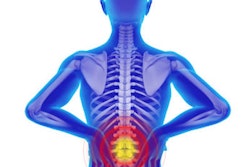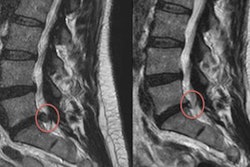
CT guidance allowed interventional radiologists to perform spinal injections just as effectively as they did using traditional fluoroscopy but with much lower personal radiation exposure, according to an article published online January 8 in Radiology. The cost? Increased radiation exposure to patients.
For patients with chronic low back pain, clinicians often recommend steroid therapy through an image-guided intervention. Among the most widely used techniques are fluoroscopy- and CT-guided spinal injections due to their ease of use and reliability, noted lead author Dr. Tobias Dietrich and colleagues from the University of Zurich in Switzerland.
Aiming to compare the safety and efficiency of these two techniques, the researchers evaluated the outcomes of 1,247 patients who underwent either a lumbar transforaminal epidural injection or facet joint injection for lower back pain. One of eight musculoskeletal radiologists performed the spinal injections using traditional fluoroscopy or CT guidance. They also recorded patient and physician radiation exposure for 199 of the cases following the "as low as reasonably achievable" (ALARA) concept for radiation dose.
There was no clinically significant difference in patient outcome as measured by patient-reported pain levels with the techniques up to one month after the procedure, the researchers found. On the other hand, radiation dose to patients was higher with CT than fluoroscopy.
Overall, the physicians' radiation exposure was 3.7 to 10 times lower during CT-guided spinal injections than it was during fluoroscopy-guided injections (p < 0.03). However, CT guidance required a statistically significant increase in patient radiation dose by a factor of 1.4 for epidural injections and 3.3 for facet joint injections, compared with fluoroscopy (p < 0.003).
| Fluoroscopy- vs. CT-guided lumbar steroid injection | ||||
| Mean | Fluoroscopy | CT | ||
| Transforaminal epidural injection | Facet joint injection | Transforaminal epidural injection | Facet joint injection | |
| Patient radiation exposure | 0.24 mSv | 0.10 mSv | 0.33 mSv | 0.33 mSv |
| Physician radiation exposure: wrist | 1.44 x 10-3 mSv | 0.46 x 10-3 mSv | 0.14 x 10-3 mSv | 0.06 x 10-3 mSv |
| Physician radiation exposure: body | 0.42 x 10-3 mSv | 0.38 x 10-3 mSv | 0.11 x 10-3 mSv | 0.08 x 10-3 mSv |
| Percentage of patients reporting lower pain* | 47% | 34% | 49% | 37% |
The benefits of CT-guided spinal injections included less radiation exposure to the interventional radiologist and improved needle steering and manipulation without the need to constantly confirm the needle's location. On the other hand, fluoroscopy-guided injections required real-time image guidance that increased radiation exposure to clinicians but decreased effective radiation dose for patients.
Clinicians also have the option of using other imaging techniques, such as ultrasound, MRI, and augmented reality, to guide lumbar injection therapies, according to the authors. Though physicians tend to feel less confident using these newer modalities, additional training and experience may enable them to further reduce the risk of radiation exposure.




















